Homeopathy and Allopathy/ Different Approaches in Treating Infectious Diseases
Summary of Article:
- Approach to treating diseases in allopathy: identify the pathogen.
- Approach in homeopathy: treat the vital force of the patient. The disturbance in the vital force is known by signs and symptoms.
- Provings, the Law of Similars, the Minimum Dose, and Trituration
- Understanding the Action of the Remedy and the Progress of the Patient
- The Homeopathic Materia Medica and How it Has Expanded Over Time
- Where Western Medicine Shines
- Qualities of a Good Doctor or Homeopath
- The Divide Between Homeopathy and Allopathy
- Why Vaccines and Antibiotics are so loved in allopathic medicine
- Mortality Rates in the 19th Century for Infectious Diseases that People Are Vaccinated Against
- Questioning the Logic Behind Combination Vaccines and Vaccine Ssafety
- Have We Replaced Common Childhood Acute Illnesses with Autoimmune Diseases with the Vaccine Program?
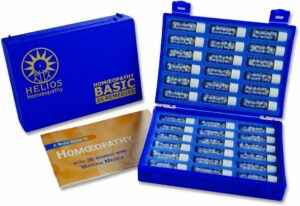
Helios Pharmacy Homeopathic Kit
In Western medicine or allopathy the treatment of acute, chronic, or epidemic diseases is geared toward identifying the cause, which is believed to be one of four types of microorganisms, and developing a treatment to target these pathogens and get the body to expel them. These four things are:
Antibiotics – for bacterial infections
Antivirals – for viral infections
Antifungals – for fungal infections
Antiparasitics – for parasitic infections
The homeopathic approach to treating infectious diseases is very different. It is not necessary to know what the carrier of the disease is, because the treatment is not directed against the disease carrier. The treatment is directed at the vital force of the patient.
In homeopathy the belief is that any disturbance in the health of the patient is really a disturbance in the vital force of the patient. The vital force can be defined as the invisible thing in the interior of man, which sustains his/her life in health when in a state of health, and when disturbed creates the disease symptoms. The disturbance of the vital force is brought to the patient’s attention through the signs and symptoms that they experience, the changes from their normal state of health. When the person dies the vital force is no longer active in the body.
The homeopath studies the signs and symptoms that the patient displays in order to understand what remedy is needed to bring order back to the disturbed vital force, so that health can be restored. In homeopathy this is accomplished by the homeopath studying the symptoms of the patient and matching them to a remedy that has produced similar symptoms in provings or in clinical use.
Provings, the Law of Similars, the Minimum Dose, and Trituration
Provings are double or single blind experiments in which healthy people take homeopathic doses of substances to see what changes this substance causes in their health. Symptoms of the different people participating in the proving are gathered together and analyzed to determine what the therapeutic action of that substance is. The intention is to find out what changes that substance can cause in human health, and therefore what that substance can treat when found in the sick. Homeopathy is based on the principle of like cures like. A substance can heal a person from a symptom that it can cause in a healthy person in the provings. This is the primary law upon which homeopathy is based: Similia similibus curenter. Let likes cure likes.
This was Samuel Hahnemann’s great discovery. It permitted doctors to have a rational basis on which to select remedies for people who are sick. It took out guess work and speculation and brought in a true scientific method based on reproducible experiments.
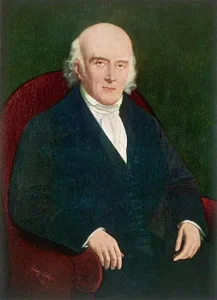
Painting of Samuel Hahnemann
Samuel Hahnemann’s next great contribution to the science of healing the sick was the utilization of the minimum dose. Two hundred years ago Hahnemann witnessed how the effects of crude substances given to sick people would cause strong toxic effects. People would often die from the medicines that they were given or suffer strong side effects. This state of affairs still continues to this day with Western medicine, because of a stubborn refusal to accept homeopathy or even look at it with an open mind.
Hahnemann’s genius was not just in realizing what common sense it was to reduce the material quantity of the medicinal substances by serially diluting them, but also by adding the additional step of succussing the dilutions between each step of the reducing process. According to James Tyler Kent in his Lesser Writings, Hahnemann started his experiments on reducing the quantity of material substance in the medicinal preparations in 1805. He published the first edition of the Organon of Medicine in 1833, so he experimented with this process to bring his understanding to a perfected form for 28 years before he presented it to the public.
The other great gift Hahnemann gave to medicine was trituration. Before Hahnemann discovered trituration substances that were not soluble in alcohol or water could not be used as medicines. Trituration is the process of grinding insoluble substances in a mortar and pestle with lactose or milk sugar, so that the particles of the substance could be made small enough to continue the potentiation process in the usual way with serial dilution and succussion. In trituration there are three one hour long grinding processes to get the substance to the 3C dilution, at which point it could then be diluted in the usual way. I won’t go into the details of how this is done. You can read about this in the Organon of Medicine. by Samuel Hahnemann.
Why I bring this up is that many substances that were previously not employable in medicine became employable by this invention. Some of these substances were considered to be inert, but the process of trituration activated or brought forth their healing properties. If this was the only gift that Hahnemann gave to the world, he would have contributed more to the benefit of mankind than any other person who ever lived. He brought to homeopathy some of our great polychrest remedies (remedies of many uses), such as Silica, which was inert in its crude form; Calcarea carbonica, which was insoluble in water and alcohol and only became medicinally active after trituration; Natrum muriaticum, ordinary table salt, which also required the process of trituration to awaken its medicinal qualities; Aurum metallic or gold, Graphites, Sulphur, Baryta carb, Platina, Zincum metallic, Stannum metallic are other substances which Hahnemann revealed the therapeutic powers of through the process of trituration.
Now 200 years later Western medicine has not caught onto the genius, the common sense and the rationality of Hahnemann’s great discoveries:
- The Law of Similars: Match the symptoms of the patient to a remedy that has produced similar symptoms in experiments on healthy people called “provings.”
- Administer the smallest possible dose of a healing substance or medicine that will stimulate a healing response.
- Make the remedies powerful yet gentle by a process of trituration, and serial dilution combined with succussion between each dilution.
Further Hahnemann wanted to determine how do we decide how often to give a dose of the remedy. How do we stimulate the organism without over or under stimulating it? What signs do we need to watch for to know that the patient needs another dose of the remedy? In Western medicine the custom is to give a substance a certain number of times a day in a routine fashion.
Understanding the Action of the Remedy and the Progress of the Patient
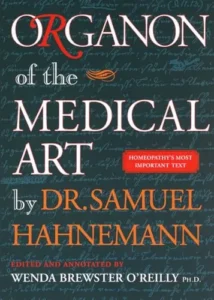
The Organon of the Medical Art by Dr. Samuel Hahnemann
In homeopathy the ideal is to observe the patient and only repeat the remedy when the dose that was given previously has exhausted its action evidenced by the beginning to relapse of symptoms that had been better. This is what Hahnemann proposed in the 4th edition of the Organon of Medicine. This was the edition that was known about during Hahnemann’s lifetime, and it was the way homeopaths in the United States, Europe, India and other places where homeopathy was practiced did their work.
The sixth edition of the Organon was not published until years after Hahnemann passed away. It was published posthumously by his wife Melanie. In the sixth edition Hahnemann introduced Quinn potencies, (commonly called LM potencies). Here Hahanemann introduced a way to give the remedy daily, every other day or some such interval by a particular method. In this method a poppy-seed sized granule of the selected remedy is dissolved in 4 oz. of water in a bottle that seals tightly. This is the stock bottle. I won’t go into this further here. Please refer to my article on LM potencies if you wish to learn more. Here is the link to my article LM Potencies and Homeopathic Posology.
The point of this digression was to show that Hahnemann put a lot of thought into how to manage a patient’s case once the remedy is administered. He wanted to answer the following questions:
- How do we know that the remedy is well selected.
- How do we know when the patient needs another dose of the remedy or not?
- How can we tell that the healing process is unfolding in the correct way and that the patient is not getting sicker from the treatment, but rather healthier. All of this Hahnemann attempted to teach in his brilliant writings.
The Homeopathic Materia Medica and How it Has Expanded Over Time
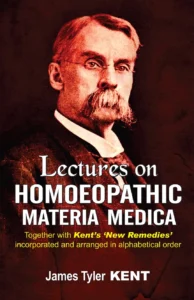
Lectures on Homeopathic Materia Medica by Dr. JT Kent
The next great contribution of Samuel Hahnemann, which is continuously being added to is the building up of the homeopathic materia medica. Any substance in nature can be turned into a homeopathic remedy. Hahnemann proved or supervised the proving of approximately 90 remedies in his lifetime. I have been told that there are now 9,000 homeopathic remedies in the homeopathic materia medica. One of my favorite materia medicas, Robin Murphy’s “Nature’s Material Medica,” has about 1500 remedies. Homeopathic research, and the conducting of provings of substances grows by leaps and bounds every year. In 1840 120 to 150 remedies were known. By 1860 300 to 400 remedies were known. By 1900 about 1500 were known.
Homeopathy is accepted and loved in many parts of the world. Unfortunately there has been a systematic attempt to eradicate homeopathy from the health care market place, from the education of doctors in medical schools and from the minds and hearts of the American people. I won’t go into the historical background of this here. There are books on the subject of the divide between Western medicine and homeopathy, which you can read to understand this further. Some books I recommend on this subject are: Harris Coulter’s, “The Divided Legacy,” and Dana’ Ullman’s book, “Discovering Homeopathy: Medicine for the 21st Century.” My article. “Vaccine Mandates and the Historical Background,” also discusses this history of the divide between homeopathy and Western medicine.
Rather than there being a divide, we really should have had a cooperative endeavor in which the strengths of each system of medicine contributed to creating a unified health care model for the society as a whole.
Where Western Medicine Shines
There are areas where Western medicine is absolutely superb. Here I am referring to the following things:
- The amazing healthcare delivery infrastructure that Western medicine has created: the amazing state of the art hospitals, the beautiful clinics, the teaching hospitals, and urgent care centers.
- The brilliant diagnostic tools that Western medicine has developed and the science of diagnosis of disease itself. Here I am referring to the labs where blood is drawn and evaluated; the imaging technologies, such as X-rays, MRI’s, and CT scans.
- The training of doctors, nurses, hospice workers, lab technicians, hospital administrators.
- The training of surgeons, physical therapists.
- Public health through government agencies: clean water, vector control.

Stanford University Hospital
Western medicine shines in these areas and is incomparable in what it has accomplished, but there are very important areas where it is weak. These are the very areas where homeopathy shines. I am referring to the treatment of acute diseases, epidemic diseases, chronic diseases, autoimmune diseases, mental illness, non-surgical traumatic injuries, though homeopathy can help with the healing process.
Qualities of a Good Doctor or Homeopath
One of my favorite reference books is James Tyler Kent’s Lectures on Homeopatrhic Materia Medica. James Tyler Kent died at age 94 in 1949. This was prior to the big explosion in the use of vaccines. From reading Kent’s Materia Medica I understand what qualities, education and experience the doctor had to have in order to treat acute infectious diseases, or chronic degenerative diseases prior to the days of vaccines
- The doctor had to have a keen eye to be able to observe all the nuances of changes in the patient’s body, demeanor, mental state, etc.
- He had to have an excellent knowledge of homeopathic materia medica, so that he could find a remedy that matched the symptoms of the patient.
- He had to be able to do comparative materia medica. This means he had to be able to distinguish the rash of say Belladonna, from that of Apis mellifica and Rhus toxicodendron.
- He had to be patient to allow the disease to develop to a point where he could see a clear picture of a remedy, and not be rash and quick to act before the indications were clear.
- He had to have a strong spirit to not interfere with his own treatment, and to not allow family members to force him /her to act against his/her better judgment.
- He had to know how to decipher the modalities of the case, such as the aggravation from a jar of Belladonna, by possibly shaking the bed and seeing the patient’s reaction, or the amelioration in the open air of Pulsatilla and Aurum. Knowing these things he could make his patient more comfortable.
What does it take to acquire this type of knowledge? It takes dedication and an excellent education and a passion for learning to acquire this kind of knowledge and skill. This is what homeopathic training is supposed to supply to the future doctors and homeopaths of the world.
The Divide Between Homeopathy and Allopathy
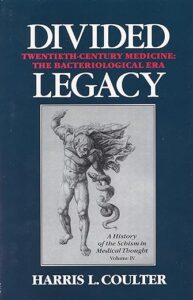
Harris Coulter’s The Divided Legacy
Unfortunately homeopathy was viewed by allopathic medicine, under the authority of the American Medical Association as a threat in the health market place. There is a lot of information on the internet about how homeopathy was systematically fought against and how it was forbidden to be taught in the Western medical schools and how homeopathic colleges, and hospitals were closed down one by one. Homeopaths were forced to study the Western medicine curriculum if they wanted to graduate from medical school. Due to that they did not have the time to study what was necessary to learn to be a homeopath.
The net result of this was that the knowledge of how to treat acute, chronic and epidemic diseases with homeopathic remedies was lost. Hence if doctors do not know how to heal people with these illnesses at the bedside or how to prevent them by strengthening the health of their patients with homeopathy, they were left with no viable alternative, but to try to prevent the diseases from arising in the first place with the use of mass immunization, so that communities would have herd immunity.
This is why vaccines are so loved in Western medicine. The hope is that doctors won’t have to encounter people with diphtheria for example, because they will have eradicated this disease from the population with the vaccination program. Doctors stopped knowing how to treat this disease properly, because they were forbidden from learning how to treat diphtheria and other diseases with homeopathic remedies in the medical schools.
Doctors of Western medicine or allopathy had other tools that were added to their tool chest in the 19th century, such as aspirin, which proved to have its problems. It is believed that that the death toll of the Spanish Flu from 1918 to 1920 was so high because of the use of aspirin. This was given in very large doses and caused a condition known as salicylate poisoning, which caused symptoms such as hyperventilation, metabolic acidosis, pulmonary edema, bleeding tendencies, confusion, delirium, seizure and coma.
Why Vaccines and Antibiotics are so loved in Allopathic Medicine
Antibiotics were discovered in 1928 and used widely after the 1940s. These were a big advance over the earlier tools that Western medicine employed such as bloodletting with leaches, and the use of drugs like Quinine and Morphine in toxic doses. These more gentle approaches did help give allopathy an edge over homeopathy at the early part of the 20th century, because people considered them to be a panacea. Unfortunately antibiotics did not prove to be a panacea, because of antibiotic resistance.
As I write this article evidence has come out that had been suppressed for quite awhile that the use of Tylenol by pregnant women can contribute to ADHD in their offspring. Evidence has also surfaced that Tylenol given after vaccination may contribute to autism in the recipient.
Vaccines are very loved in Western Medicine, because it has in large part eradicated some of the infectious diseases that humanity has dealt with for centuries. That would be great if there was no price to be paid for the benefit. The question is does the benefit outweigh the harm or vice versa.
Mortality Rates in the 19th Century for Infectious Diseases that People Are Vaccinated Against
Most of the infectious disease for which children or adults are vaccinated against are acute illnesses that usually last for approximately seven days in healthy people. I asked ChatGPT: “What was the mortality rate in the 19th century for the diseases that people are currently vaccinated against” These were the statistics from I was given. These statistics are for people treated by Western medicine.
Smallpox 20 to 30% higher in children
Diphtheria 5 to 10%, up to 20% in children
Pertusis 4 to 6% in infants: lower in older children
Measles 5 to 15%
Scarlet fever 15 to 30%. This is not an illness that people are vaccinated against, but it has reduced due to antibiotics.
Typhoid Fever 10 to 20%
Tuberculosis 50% if untreated
Polio 5 to 10%
Tetanus 80 to 90%, “Neonatal tetanus was a major cause of infant death.”
Cholera 30 to 50%
Mumps, Rubella, Varicella (Chickenpox) well under 1%.
There are a few interesting things that one can see here.
Questioning the Logic Behind Combination Vaccines and Vaccine Safety
The DPT vaccine for diphtheria, pertussis and tetanus has been one of the most implicated vaccines in autism. It is interesting to see that the mortality rate for diphtheria and pertussis when when treated by Western medicine was quite low. It would be significantly lower if treated with homeopathy. The mortality rate for tetanus was quite high. We have two remedies in homeopathy that are very good for treating tetanus: Hypericum perforatum and Ledum palustre. These are excellent alternatives to the tetanus vaccine that do not have to be given prophylactically, but can be used when there has been an event, such as stepping on a rusty nail that’s embedded in cow dung that would put a person at risk of tetanus. My point is that this is a dangerous vaccine and there are excellent alternatives to the vaccine in homeopathy, and the mortality rate for the D and the P portion are low when treated allopathically. Also my question is why vaccinate for these three very different diseases at the same time. No one would be exposed to these three diseases simultaneously in natural circumstances. So why force this highly dangerous vaccine rio into tiny babies and put the most precious people in our society at risk.
Now let’s take up measles, mumps, rubella and chicken pox. All of these diseases had low mortality rates in the 19th century prior to the use of vaccines. The vaccines with these diseases show high rates of harm, and are highly implicated in autism. I don’t think there is a better word I can use to express my credulousness, except that this is insanity.
To save doctors the trouble of getting a good education and learning how to treat these infectious diseases in an intelligent fashion with homeopathy, Western medicine has chosen to vaccinate the innocent with harmful vaccines. They have also chosen to keep the doctors that they train in a state of ignorance by not telling them about the existence of homeopathy, and by not giving them the option to learn about this therapeutic science in their medical schools. What a disastrous state of affairs.
Have We Replaced Common Childhood Acute Illnesses with Autoimmune Diseases with the Vaccine Program?
The vaccine program poses another threat to the population that Western medicine is not taking a look at. Most of the diseases for which children are vaccinated against are acute diseases, which last for about a week in healthy children, and longer in the less healthy. What the vaccines have done is that they have caused a general decline in the health of the population. Now children are less likely to be susceptible to these acute diseases, because these diseases are diseases of the healthy.
What has happened is that the level of health has dropped down significantly to the point where children are getting autoimmune diseases, or what we call in homeopathy trimiasmatic diseases. These are diseases that are much more difficult to treat, and represent a confused mess in the immune system. Here I am referring to cancer, asthma, allergies, autism, and autoimmune diseases.
I asked ChatGPT to compare current rates of these diseases to 1900. Basically it tells me that records about these diseases were not kept in the 1900’s, but in general there has been a rise in cancer, asthma, and autoimmune disease and allergy rates, but that the mortality rates are low due to modern treatment.
I asked for a comparison of autism rates. This is the information I got:
“Current Autism Rates
- In the U.S., the CDC’s most recent estimate (2022 data for 8-year-olds) is about 1 in 31 children (? 3.2%) are identified with autism spectrum disorder (ASD). CDC+3CDC+3ABA Centers of America+3
- Among 4-year-olds, the prevalence is estimated at about 1 in 34 (? 2.9%) in recent reports. Autism Speaks+1
- The prevalence has been increasing over time in the U.S. (and in many other countries) in the latter part of the 20th and into the 21st century. Leadership in Focus+2BioMed Central+2“
Food for thought:
Have we replaced childhood acute illnesses with much more serious, long lasting, life-debilitating diseases with the vaccine program. This is a question we are not supposed to ask, because vaccines have now become a medical tradition. It is heresy to question the status quo. We are a society that protects the doctors and sacrifices their patients, our precious children. We are a society that has chosen not to demand that our doctors be educated in homeopathy. Education in homeopathy would demand a total rethinking of the curriculum that is taught in allopathic or Western medicine universities. This would be a massive overhaul of how things are currently done. We have now had a century of the near monopoly of allopathic medicine in the healthcare marketplace, and the results have not been positive for the American population.
Thank you for reading this article. I hope it has given you food for thought. Please share it with others. We can cause societies to rethink their paradigms by education, how we vote in elections and by spreading the word.
Wishing you health and happiness,
Deborah Olenev CCH RSHom (NA)